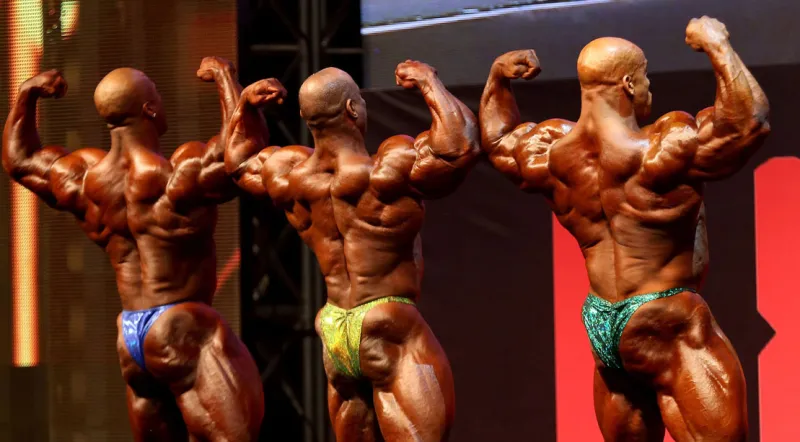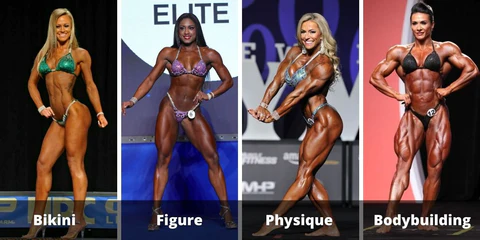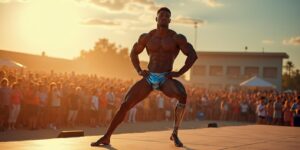
Men’s Bodybuilding
Men’s Bodybuilding is the division that most people think of when they hear the term “bodybuilding.” This division is all about extreme muscle mass, size, and definition. Competitors in this division aim to achieve the most muscular and ripped physique possible. The judging in Men’s Bodybuilding is based on muscularity, symmetry, conditioning, and stage presence. In terms of posing routines, competitors in Men’s Bodybuilding perform a series of mandatory poses that showcase their muscle development from every angle. These poses include the front double biceps, side chest, back double biceps, and many more. The goal is to display the maximum amount of muscle mass and definition while maintaining a balanced and aesthetically pleasing physique. To compete in Men’s Bodybuilding, intense training and a strict nutrition plan are necessary. This division requires a significant amount of muscle mass, which can only be achieved through consistent weightlifting and progressive overload. Nutrition plays a crucial role in fueling muscle growth and achieving low body fat levels. Competitors must follow a well-structured diet that includes an adequate amount of protein, carbohydrates, and healthy fats.Women’s Bodybuilding
Women’s Bodybuilding is the female counterpart to Men’s Bodybuilding. This division focuses on developing muscularity, size, and definition while maintaining a feminine physique. The judging criteria for Women’s Bodybuilding are similar to that of the men’s division, with an emphasis on muscularity, symmetry, conditioning, and stage presence. In terms of posing routines, women in this division perform a series of mandatory poses that highlight their muscle development and overall physique. These poses include the front double biceps, side triceps, back lat spread, and many more. The goal is to showcase a balanced and well-defined physique while maintaining a feminine look. To compete in Women’s Bodybuilding, women must dedicate themselves to intense weightlifting and follow a strict nutrition plan. Building muscle mass requires heavy lifting and progressive overload, just like in Men’s Bodybuilding. Nutrition plays a crucial role in fueling muscle growth and achieving low body fat levels. Competitors must follow a well-structured diet that includes an adequate amount of protein, carbohydrates, and healthy fats.Classic Physique
The Classic Physique division is a nod to the golden era of bodybuilding, with a focus on classic aesthetics and proportions. This division aims to showcase a physique that is reminiscent of the legendary bodybuilders from the 1960s and 1970s, such as Arnold Schwarzenegger and Frank Zane. The judging criteria for Classic Physique include overall aesthetics, muscle shape and size, symmetry, and stage presence. In terms of posing routines, Classic Physique competitors perform a series of mandatory poses that emphasize their overall aesthetics and proportions. These poses include the front double biceps, side chest, back double biceps, and many more. The goal is to showcase a well-developed and symmetrical physique that exudes timeless beauty. Training for the Classic Physique division requires a balance between muscle mass and aesthetics. Competitors must focus on building muscle size and shape while maintaining a classic and proportionate look. Nutrition plays a crucial role in achieving the desired physique, and competitors must follow a well-structured diet that supports muscle growth and maintains low body fat levels.Men’s Physique
Men’s Physique is a division that focuses on a more beach-ready physique. Competitors in this division aim to achieve a muscular and lean physique without the extreme muscle mass of Men’s Bodybuilding. The judging criteria for Men’s Physique include muscularity, conditioning, symmetry, and stage presence. In terms of posing routines, Men’s Physique competitors perform a series of poses that showcase their physique from the front and back. These poses include the front pose, side pose, back pose, and many more. The goal is to display a well-developed and aesthetically pleasing physique that is not overly bulky. To compete in Men’s Physique, training focuses on building lean muscle mass and achieving a balanced and symmetrical physique. Nutrition plays a crucial role in achieving low body fat levels while maintaining muscle definition. Competitors must follow a well-structured diet that includes an adequate amount of protein, carbohydrates, and healthy fats.
Women’s Physique
Women’s Physique is a division that combines muscularity with femininity. Competitors in this division aim to achieve a muscular and defined physique while maintaining a feminine look. The judging criteria for Women’s Physique include muscularity, conditioning, symmetry, and stage presence.
In terms of posing routines, women in this division perform a series of poses that showcase their physique from the front and back. These poses include the front pose, side pose, back pose, and many more. The goal is to display a well-developed and aesthetically pleasing physique that is not overly muscular.
Training for Women’s Physique requires a focus on building lean muscle mass and achieving a balanced and symmetrical physique. Nutrition plays a crucial role in achieving low body fat levels while maintaining muscle definition. Competitors must follow a well-structured diet that includes an adequate amount of protein, carbohydrates, and healthy fats.
Fitness
Fitness is a division that combines athleticism with physique. Competitors in this division are judged on their physique as well as their performance in a routine that includes strength, flexibility, and dance elements. The judging criteria for Fitness include overall physique, routine performance, stage presence, and athletic ability.
In terms of posing routines, Fitness competitors perform a routine that showcases their physique and athletic abilities. This routine can include strength moves, flexibility poses, dance elements, and more. The goal is to display a well-rounded and entertaining performance that highlights both the physique and the athletic prowess of the competitor.
Training for Fitness requires a combination of strength training, flexibility training, and cardiovascular exercise. Competitors must have a well-rounded fitness routine that includes weightlifting, stretching, and cardiovascular activities. Nutrition plays a crucial role in fueling performance and maintaining a lean physique. Competitors must follow a well-structured diet that includes an adequate amount of protein, carbohydrates, and healthy fats.
Figure
Figure is a division that focuses on a well-defined and symmetrical physique. Competitors in this division aim to achieve a balanced and athletic look with good muscle definition. The judging criteria for Figure include overall symmetry, muscularity, conditioning, and stage presence.
In terms of posing routines, Figure competitors perform a series of mandatory poses that showcase their physique from the front and back. These poses include the front pose, side pose, back pose, and many more. The goal is to display a well-proportioned and aesthetically pleasing physique with good muscle definition.
Training for Figure requires a focus on building lean muscle mass and achieving a balanced and symmetrical physique. Nutrition plays a crucial role in achieving low body fat levels while maintaining muscle definition. Competitors must follow a well-structured diet that includes an adequate amount of protein, carbohydrates, and healthy fats.
Bikini
Bikini is a division that focuses on a fit and feminine physique. Competitors in this division aim to achieve a toned and athletic look without excessive muscle definition. The judging criteria for Bikini include overall beauty, balance, shape, and stage presence.
In terms of posing routines, Bikini competitors perform a series of poses that showcase their physique from the front and back. These poses include the front pose, side pose, back pose, and many more. The goal is to display a fit and feminine physique with a healthy and toned appearance.
Training for Bikini requires a focus on overall fitness and maintaining a toned physique. Competitors must engage in regular strength training, cardiovascular exercise, and flexibility training. Nutrition plays a crucial role in achieving a fit and toned look. Competitors must follow a well-structured diet that includes an adequate amount of protein, carbohydrates, and healthy fats.
Let’s Sum Up
Choosing the right bodybuilding division is crucial for maximizing your potential for success on the stage. Each division offers a unique set of challenges and opportunities, so it’s important to understand the criteria and requirements of each category. Whether you’re aiming for extreme muscle mass in Men’s Bodybuilding or a fit and feminine look in Bikini, the world of bodybuilding has a division for everyone. So, dive in, work hard, and showcase your hard work and dedication on the bodybuilding stage.





